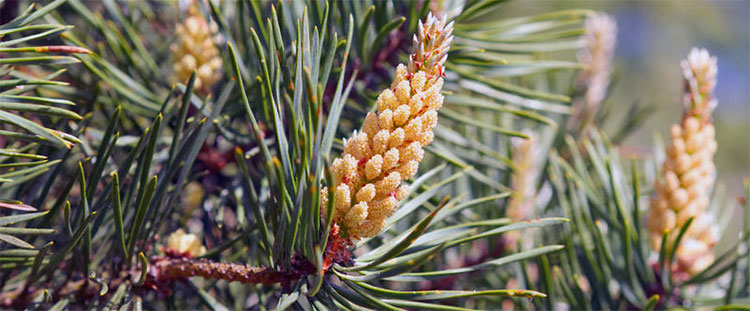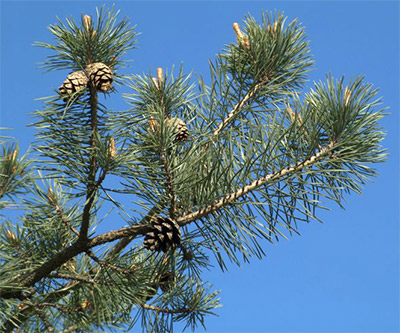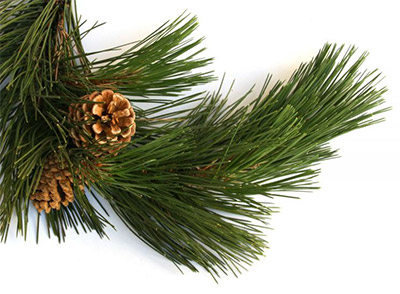Scotch Pine Essential Oil
Pinus sylvestris

Description
Scotch Pine Essential Oil is also known as Scots Pine Essential Oil and sometimes also just goes by the name Pine Essential Oil.
Scotch Pine Essential Oil is produced by steam distilling the needles of Pinus sylvestris, a tall coniferous tree.
Containing approximately 90% monoterpenes, Scotch Pine Essential Oil is a good respiratory and antimicrobial oil. It is well regarded for its use in household cleaning applications. Due to its high monoterpene content, it oxidizes easily. It is best to store it in the fridge to help extend its shelf life.

For emotional and spiritual applications, Scotch Pine Essential Oil is considered a cleansing and a clearing essential oil, and it can be helpful for clearing the mind of clutter and helping to clear a space of negativity prior to meditation. It is an energizing and uplifting oil that can help combat fatigue and support focus.
Aromatically, Scotch Pine Essential Oil possesses a crisp, fresh pine aroma that blends well with other conifer essential oils and oils in the wood, resin and herbaceous families. I especially love blending it with citrus essential oils when I am in need of a refreshing blend.
For more information about pine and conifer oils, read AromaWeb's Guide to Coniferous Essential Oils.
Scotch Pine Essential Oil Benefits and Uses
- Colds
- Coughing
- Flu
- Rheumatism
- Sinusitis
- Rheumatism
- Muscular Pain/Injury/Fatigue
- Gout
- Bronchial Infection
- Sinus Congestion
- General Debility
- Fatigue
- Mental And Nervous Exhaustion
Sources: Valerie Ann Worwood, The Complete Book of Essential Oils and Aromatherapy, 25th Anniversary Edition (Novato, CA: New World Library, 2016, 614. Julia Lawless, The Encyclopedia of Essential Oils (Updated Edition) (London: Harper Thorsons, 2014), 165-166.
Botanical Name
Plant Family
Common Method of Extraction
Steam Distilled
Plant Part Typically Used

Color
Clear to Pale Yellow
Consistency
Medium
Perfumery Note
Top
Strength of Initial Aroma
Medium

Aromatic Description
Scotch Pine Essential Oil smells fresh, woody, earthy and balsamic.
Sustainability and Conservation Status
Least Concern
Source: https://www.iucnredlist.org/species/42418/2978732
To learn more about the conservation status of essential oil bearing plants and how to use the IUCN Red List of Threatened Species, please refer to AromaWeb's Guide to Essential Oils and Sustainability.
Major Constituents
- a-Pinene
- B-Pinene
- Delta-3-Carene
- B-Phellandrene
- Delta-Cadinene
- Camphene
See Essential Oil Safety for more complete list of typical constituents.
Source: B.M. Lawrence, Essential Oils 1988-1991 (Wheaton: Allured Publishing, 1993), 140-143.A. Orav, T. Kalias, M. Liiv. Analysis of Terpenoic Composition of Conifer Needle oils by Steam Distillation/Extraction Gas Chromatography and Gas Chromatography-Mass Spectrometry. (Chromatographia 43, 1996), 215-219. Sources cited in Robert Tisserand and Rodney Young, Essential Oil Safety (Second Edition. United Kingdom: Churchill Livingstone Elsevier, 2014), 398.
Scotch Pine Essential Oil Safety Information
Tisserand and Young do not indicate any special precautions when using Scotch Pine Essential Oil. However, they precaution to avoid use of the oil if it has oxidized. Reading Tisserand and Young's full profile is recommended. [Robert Tisserand and Rodney Young, Essential Oil Safety (Second Edition. United Kingdom: Churchill Livingstone Elsevier, 2014), 398-399.]
General Safety Information
Do not take any oils internally and do not apply undiluted essential oils, absolutes, CO2s or other concentrated essences onto the skin without advanced essential oil knowledge or consultation from a qualified aromatherapy practitioner. For general dilution information, read AromaWeb's Guide to Diluting Essential Oils. If you are pregnant, epileptic, have liver damage, have cancer, or have any other medical problem, use oils only under the proper guidance of a qualified aromatherapy practitioner. Use extreme caution when using oils with children and be sure to first read the recommended dilution ratios for children. Consult a qualified aromatherapy practitioner before using oils with children, the elderly, if you have medical issues or are taking medications. Before using this or any essential oil, carefully read AromaWeb's Essential Oil Safety Information page. For in-depth information on oil safety issues, read Essential Oil Safety by Robert Tisserand and Rodney Young.
Shelf Life
Important Information About the Profiles
The essential oil information provided on AromaWeb is intended for basic educational purposes only. The references to safety information, test results, constituents and percentages is generalized information. Essential oils can vary greatly in composition. The data is not necessary complete and is not guaranteed to be accurate. The essential oil photos are intended to represent the typical and approximate color of each essential oil. However, essential oil composition and color can vary based on harvesting, distillation, age of the essential oil and other factors. Profiles for several CO2 Extracts and absolutes are included within the directory, and are denoted as such.
